[동아시아포럼] 일본, 새로운 아세안 ODA 전략 모색해야
일본, 경기침체 장기화로 ODA 지출 감소 아세안 국가 인프라 개발사업 수주 한계 ODA 영향력 약화에도 국가간 조정 역할
[동아시아포럼]은 EAST ASIA FORUM에서 전하는 동아시아 정책 동향을 담았습니다. EAST ASIA FORUM은 오스트레일리아 국립대학교(Australia National University) 크로퍼드 공공정책대학(Crawford School of Public Policy) 산하의 공공정책과 관련된 정치, 경제, 비즈니스, 법률, 안보, 국제관계에 대한 연구·분석 플랫폼입니다. 저희 폴리시코리아(The Policy Korea)와 영어 원문 공개 조건으로 콘텐츠 제휴가 진행 중입니다.
일본은 아세안(ASEAN·동남아시아국가연합)이 결성된 1967년 이후 아세안 국가를 대상으로 공적개발원조(Official Development Assistance, ODA)를 제공해 왔다. 실제로 2000년대까지 일본은 아세안 회원국에 가장 많은 재정과 기술자원을 지원한 국가로 꼽혔다.

아세안 국가들의 기반시설 건설 원조한 일본
지금까지 일본의 ODA 대부분은 아시아 지역 국가들을 대상으로 추진돼 왔으며 일부 장애요인에도 불구하고 지속적으로 그 규모가 증가하고 있다. 일본의 ODA 순지출은 1960년 1,050만 달러(약 13억원)에서 1995년 145억 달러(약 18조8,000억원)로 증가했다. 1992년 버블경제 붕괴 이후 ODA가 축소되면서 2007년 ODA 순지출은 77억 달러(약 9조9,000억원)로 역대 최저치를 기록했지만 2021년 다시 157억 달러(약 204,000억원)로 확대됐다. 현재까지 일본으로부터 원조를 받은 상위 10개국 중 5개국이 아세안 국가로, 원조 대부분은 경제 발전의 필수요소인 도로, 교각, 공항, 발전소, 산업단지 등 기반시설을 건설하는 데 투입됐다.
1970~80년대 일본의 ODA는 경제적으로 독립하지 못한 초기 아세안 회원국의 성장에 큰 도움을 줬다. 개발도상국의 기반시설을 건설하는 작업은 그 나라의 국민과 기업에도 이익이 됐을 뿐 아니라 일본을 비롯한 선진국의 투자를 유치함으로써 해당국의 경제 발전을 가속화시켰다. 1990년대 아세안에 가입한 라오스, 미얀마, 베트남, 브루나이 등 4개국도 이같은 과정을 거쳤다. 1990년대 들어 일본은 태국 동부 해안과 메콩강 주변에 산업단지, 교각 등 인프라를 구축하는 ODA를 진행했으며 동아시아 국가들의 성장세를 메콩 지역 주변국으로 확대하는 데 기여했다.
하지만 1990년대 이후 버블경제의 붕괴로 인해 일본의 경기 침체가 장기화되면서 아세안 국가에 대한 일본의 원조 의지가 약화됐다. 여기에 아세안 국가에 대한 인프라 투자 비용이 증가하면서 일본의 ODA는 어려움에 직면했다. 동남아시아 국가들이 발전하면서 최근에는 일본과 아세안 국가들 간의 인프라 개발 목표도 격차가 줄어들었다. 실제로 인도네시아, 말레이시아, 태국, 베트남 등 아세안 국가들은 일본의 고속철도를 들여오기를 희망했고 일본도 이를 긍정적으로 검토했지만 고속철도를 건설하는 비용이 ODA 예산을 초과하면서 지속적인 지원이 어려워졌다.
한국, 중국, 태국 등 ODA 경쟁국으로 부상
일본이 ‘잃어버린 30년’을 지나오는 동안 아세안 국가들을 원조할 수 있는 기술력과 재원, 정치적 의지를 가진 경쟁국들이 등장한 것도 일본의 입지를 약화시키는 데 영향을 미쳤다. 일본이 ODA에 소극적으로 대응하는 사이 한국, 중국, 태국 등이 기반시설의 유형에 따라 아세안 국가의 인프라 공급자로 나서고 있다. 이들은 수혜국들을 대상으로 일본에 비해 경쟁력있는 가격을 제시함은 물론 수혜국이 원하는 요구를 수용하면서 제약사항이나 대출조건, 비용을 유연하게 조정해 주고 있다.
일례로 태국의 경우 방콕과 치앙마이를 잇는 고속철도를 건설하는 과정에서 일본 개발사에게 지급하는 비용 부담을 줄이기 위해 최고설계속도와 정차지점을 줄이는 방안을 검토했다. 이런 와중에 새로운 공급자들이 경쟁력 있는 가격과 유연한 조건을 제시하면서 태국은 기존에 계획했던 목표대로 기반시설을 구축할 수 있게 됐다. 반면 일본은 새로운 인프라 공급자의 등장으로 인해 아세안 국가들이 발주하는 대규모 프로젝트의 계약을 성사시키기 어려워졌다.
아세안 국가의 최종 목표는 재정과 기술력을 강화해 자체적으로 인프라 개발이 가능하도록 하는 데 있다. 하지만 가까운 미래에는 이러한 목표를 달성하기 어려울 것으로 보인다. 대부분의 아세안 국가들은 자체적으로 인프라 산업을 육성하기에는 경제 규모가 작기 때문이다. 경제적으로 발전한 아세안 주요국들조차 현지 기업들이 기반시설을 구축할 수 경쟁력을 갖춘 경우가 매우 드물어 결국 인프라 개발을 외부 지원에 의존할 수 가능성이 높다.
최근 들어 일본이 동남아시아 지역의 대규모 인프라 개발 사업을 수주하는 데 어려움이 있다고 하더라도 아세안 국가들이 직면한 복잡하고 다양한 현안을 개선하기 위해서는 일본의 참여가 상당히 중요하다. 인프라 개발은 국가의 경제 성장을 촉진시킬 수 있지만 지나칠 경우엔 오히려 아세안 지역 전체를 어려움에 빠트릴 수 있다. 이 때문에 아세안 국가들은 인프라 개발을 위한 대규모 프로젝트를 시작하기 전에 실행 가능성에 대한 연구와 타당성 조사를 진행하는데 일반적으로 일본을 최우선 협력 파트너로 선택하는 경우가 많다. 다만 일본은 비용이 많이 드는 최신의 기술 표준을 지나치게 강조하는 경향이 있다. 일본이 제시하는 기술 표준은 선진국들도 감당하기 어려운 수준이다. 일본이 수혜국의 입장에서 보다 실용적이고 현실적인 대안에 중점을 적절한 수준의 성과를 도출할 수 있도록 제안할 필요가 있다는 지적이 나오는 이유다.
FDI 방식 PPP, ODA 네트워크 활용 등 검토
기반시설은 공공재이자 사유재의 성격을 모두 가지고 있어 개발사업을 추진하는 데 제한이 있다. 주요국의 인프라 개발사업은 주로 민관협력사업(Public and private partnerships, PPP)으로 추진된다. 특히 고속철도와 같은 기반시설은 선진국의 민간기업과의 협력이 특히 중요하다. 이 경우 민간기업이 자금을 출자해 정부의 인프라 개발사업을 수행하고 건설이 완료된 기반시설을 국민과 기업들이 이용하면서 공공분야에서 수익을 창출하는 방식으로 추진된다. 하지만 대부분의 아세안 국가들은 재정이나 기술력에 한계가 있어 먼저 기반시설을 건설하고 사후에 이익을 회수하는 방식으로는 인프라 개발이 어렵다.
일본 기업들은 그동안 수익성과 주주 우선주의의 원칙을 고려해 아세안 국가의 고속철도 프로젝트에 참여하는 것을 주저해 왔다. 하지만 지난 수십 년간 일본의 다국적 기업들은 아세안 지역을 기반으로 성장해 온 만큼 아세안 국가의 발전에도 동일한 책무를 가져야 한다. 인프라 개발 기업들은 프로젝트를 수행하는 과정에서 막대한 재원을 확보하는 반면 개발도상국의 값싼 노동력을 활용함으로써 비용을 절감해 이익을 얻는데 최근에는 일본과 아세안 국가들간의 소득 격차가 줄어들면서 이러한 방식도 기업의 이익을 가져다주는 데는 한계가 있다. 이러한 상황을 고려할 때 외국인직접투자(FDI) 방식의 PPP를 진행함으로써 인프라 수출을 확대하는 방안을 검토할 필요가 있다.
일본은 중국이나 한국에 비해 아세안 국가들에 대한 FDI가 뒤처져 있다. 하지만 아세안 전역에 걸친 원조 네트워크 측면에서는 여전히 가장 앞선 것으로 평가된다. 특히 일본국제협력기구(JICA)와 일본무역진흥기구(JETRO)는 조직 규모와 업무 범위, 현지 경제와 동남아시아 사회에 미치는 영향 면에서 여전히 한국이나 중국보다 뛰어나다.
하나의 국가가 단독으로 실행하기 불가능한 인프라 개발사업이라도 원조 네트워크를 통해 다른 아세안 국가들과 연계함으로써 실현 가능성을 확보할 수 있다. 그동안 일본 기업들은 아세안 지역에서의 초국경 협력이 아세안 전역에서 성과를 달성하는 효과적인 방법임을 증명했다. 1990년대 이후 ODA 분야에서 일본의 영향력이 약화됐다 할지라도 일본의 원조 네트워크는 유럽, 미국, 중국 등 주요국과 아세안 간의 지속적인 협력을 지원하고 조정함으로써 아세안의 인프라 개발을 촉진하는 데 주요한 역할을 하고 있다.
Japan builds on ASEAN’s infrastructure ambitions
Japan was ASEAN’s largest provider of financial and technical resources until the 2000s. Japan’s overseas development aid (ODA) through loans and grants to ASEAN member states goes back to 1969, two years after ASEAN was formed.

Japan’s annual net ODA, most of which is directed towards Asian countries, continues to grow despite some major setbacks. It grew from US$105 million in 1960 to US$14.5 billion in 1995, before declining when Japan’s asset bubble burst in 1992. Japan’s net ODA hit a low at US$7.7 billion in 2007, but rose to US$15.7 billion in 2021, with five ASEAN countries among the top 10 recipients. Much ODA went to the construction of roads, bridges, airports, powerplants and industrial estates, all essential to economic development.Infrastructure aid was helpful to the original ASEAN members during their early independence. It benefited not only local people and firms but also attracted investment from Japan and other industrialised nations, which jump-started economic development.
The same cycle repeated for the four new ASEAN members who joined in the 1990s. In mainland Southeast Asia, Japanese ODA enabled the construction of bridges and estates along Thailand’s Eastern Seaboard and the Mekong River, extending growth to the whole Mekong region.But Japan’s contribution to infrastructure development among ASEAN states has also faced setbacks amid two long-term changes in Japan’s relative economic position. ASEAN’s infrastructure ambitions were easier to support when Japan’s economy was stronger and the cost of infrastructure investments in ASEAN countries fell below Japan’s aid allocation ceilings.
Over time, the gap between Japan’s and ASEAN’s infrastructure ambitions has shrunk. ASEAN countries want high-speed railways — Indonesia, Malaysia, Thailand and Vietnam have all expressed their intention to import Japanese bullet trains. Japan’s responses were positive but the costs exceeded ODA budgets.Another change in Japan’s relative economic position has been the emergence of regional competitors with the technical capacity, financial resources and the political will to participate in infrastructure development in ASEAN. Depending on the type of infrastructure, China, South Korea and intra-ASEAN players such as Thailand have become active infrastructure providers in ASEAN.
These new providers offer competitive pricing and are often more flexible in adjusting loan terms, cost provisions based on the constraints and accommodating the needs of recipient countries.For example, Thailand has proposed reducing the speed and number of stops along the planned high-speed railway between Bangkok and Chiangmai as well as the overall contributions of the Japanese developer to reduce costs.
Such requests do not appear to have been considered seriously. The new and more flexible regional providers have made it more difficult for Japan to settle deals while maintaining its high standards.The ultimate goal is for ASEAN to become technically and financially capable enough to meet its own infrastructure aims. This is unlikely in the foreseeable future. Some ASEAN members are too small to foster local infrastructure industries. Local supply infrastructure scenarios are unrealistic even in the more economically advanced ASEAN member states, judging by the fact that catch-up by local firms is rarely seen even in less sophisticated industries. ASEAN’s infrastructure development will continue to rely on external assistance.
Despite difficulties in striking deals, Japan’s involvement may increase in importance given the complex and multifaced challenges that ASEAN nations are facing.Ambition drives progress but overenthusiastic ambition may put ASEAN in difficult situations later. Japan is well-placed to help ASEAN nations evaluate their goals. It is usually the first partner that ASEAN countries turn to for feasibility studies of major infrastructure development projects. But Japan needs to be cautious about conforming to modern feasibility studies standards that overemphasise expensive ‘state-of-the-art’ criteria, which even developed countries struggle to afford.
Focusing on realistic alternatives is more likely to lead to practical and appropriate outcomes.Infrastructure development is difficult to execute because basic facilities have the character of both public and private goods. Public and private partnerships (PPP), where private companies fund government projects upfront and then earn revenue from their public use, may be the best way forward. This means larger contributions from public ODA and private players in the more developed ASEAN countries. The ‘build and leave’ alternative will not work in most ASEAN countries because of limited financial and technical capabilities. For PPP to work in modern infrastructure projects, such as high-speed railways, private partner commitments from developed countries are likely to be especially important.
Profitability and accountability to shareholders is the main reason that Japanese providers have been reluctant to proceed with bullet train projects in many ASEAN countries. But multinational manufacturing enterprises, including Japanese firms, have thrived in ASEAN for decades bearing the same accountability. The provision of infrastructure relies on higher-income consumers, while manufacturing companies benefit from lower wages.
The shrinking income gap between Japan and ASEAN may make it easier for Japan to carry out FDI-oriented PPP for infrastructure development and expand Japanese infrastructure exports.Japan’s FDI in some ASEAN countries has been overtaken by China or South Korea. But Japan is still number one when it comes to the network of aid and quasi-aid agencies across ASEAN. The Japan International Cooperation Agency and the Japan External Trade Organization still outperform similar organisations from China and South Korea in terms of the scale and range of operation and the impacts on local societies and economies.
Japanese manufacturing companies have shown how cross-border cooperation is an effective way to achieve overall efficiency in ASEAN. An infrastructure project that is not feasible in one ASEAN country may become viable when connected with infrastructure in other ASEAN countries. With its aid and quasi-aid networks, Japan is well-placed to coordinate intra- and extra-regional assistance with Europe, the United States, China and other countries to promote ASEAN’s continued infrastructure development.
원문의 저자는 일본 경제개발연구소(Institute for Developing Economies) 경제지리학 연구팀의 수크닐란 케올라(Souknilanh Keola) 부국장입니다.



























